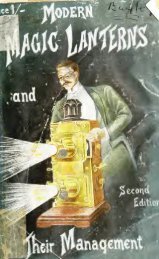The Art of projection and complete magic lantern ... - Yesterday Image
The Art of projection and complete magic lantern ... - Yesterday Image
The Art of projection and complete magic lantern ... - Yesterday Image
- No tags were found...
Create successful ePaper yourself
Turn your PDF publications into a flip-book with our unique Google optimized e-Paper software.
37far back but equally flat to the body. After the <strong>lantern</strong> is lighted up <strong>and</strong>the metal work becomes heated, it will exp<strong>and</strong> <strong>and</strong> throw the discs out,it is then a very simple matter to give the rods a minimum turn to bringthe fronts up to the required degree <strong>of</strong> accuracy, which is no easy matterwhen it has to be done by the milled nut in front, which is the casewhen these registering rods are not fitted.THE ROLLING DIAPHRAGM, OR CURTAIN EFFECT.This illusion was first invented by Mr. B. J.Maiden, <strong>and</strong> he wasenabled to keep the secret for two years before it became known by whatmeans it was brought about. In use it has the effect <strong>of</strong> one picturerolling up <strong>and</strong> a second appearing beneath it <strong>and</strong> on the reverse movement,the picture is rolled down over the preceding view. In a great many<strong>lantern</strong>s this is defective in the following respect, if in rolling the picturethere is a heavy dark b<strong>and</strong> shown, it is because the diaphragm is too long,a little is required to be taken <strong>of</strong>f the bottom <strong>of</strong> the brass diaphragm, ifon the contrary there is a white b<strong>and</strong>, it is because the diaphragm is tooshort ; the former is easily remedied by filing away, but the latter is onlyto be remedied by piecing, or the making <strong>of</strong> a new diaphragm.With the ordinary rolling shutter, in commencing an exhibition, theshutter is pulled or racked up, the curtain slide placed in the middle <strong>lantern</strong><strong>and</strong> the view in the top, <strong>and</strong> upon the diaphragm being brought down,the illusion is produced <strong>of</strong> the curtain rolling up, this when used withstatuary is very effective, <strong>and</strong> should be iritroduced at times during anexhibition in lieu <strong>of</strong> dissolving, being a nice change. Many improvementshave been recently added to the original idea, which was a sheet <strong>of</strong>vulcanite worked between the two <strong>lantern</strong>s by means <strong>of</strong> a brass lever, itwas next made <strong>of</strong> brass <strong>and</strong> lifted up <strong>and</strong> down from the top <strong>of</strong> the<strong>lantern</strong>, being capable <strong>of</strong> being drawn out when not required. A rackwas next added to facilitate the motion, <strong>and</strong> a recent patent <strong>of</strong> Mr.Hughes' enables the rolling diaphragm to be used in all three <strong>lantern</strong>s,<strong>and</strong> at no time is the diaphragm required to be withdrawn, which is thecase with the ordinary form. When the <strong>lantern</strong> is on an elevatedposition, it is not an easy matter to draw the diaphragm out (which runsthe length <strong>of</strong> two <strong>lantern</strong>s) especially if the <strong>lantern</strong> is placed underneatha gallery <strong>and</strong> the top nearly touching the ceiling. This difficultyis overcome by the aid <strong>of</strong> supplemental shutters, or brass discs, which aremade to drop down into position when in use, or to lift up out <strong>of</strong> theway when dissolving. <strong>The</strong> first to introduce the idea <strong>of</strong> supplementalshutters, we believe was Mr. Steward. For working <strong>of</strong> the diaphragmin the three <strong>lantern</strong>s according to the illustration:— 6^ is the





